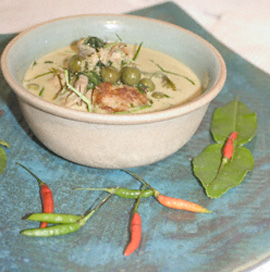 Having made the Thai green curry paste in my earlier posting, the next step is to make Thai green curry. Most recipes I’ve seen give versions for Thai green curry with chicken, but I used pork because we prefer it. The method is the same anyway so you can use pork or chicken as you prefer.
Having made the Thai green curry paste in my earlier posting, the next step is to make Thai green curry. Most recipes I’ve seen give versions for Thai green curry with chicken, but I used pork because we prefer it. The method is the same anyway so you can use pork or chicken as you prefer.
You could even make a vegetarian version with mushrooms or whatever, but take care – it’s quite easy to stumble into the pitfalls of making vegetarian Thai food because much of it relies on condiments such as nam pla (fish sauce), which is made from fermented fish. I do have at least one (I have so many books I lose track sometimes) Thai vegetarian cookbook which I’ll explore further later on.
Please see my page about Thai ingredients for more information about them and what they’re typically used for.
Meanwhile, let’s proceed with this pork (or chicken) version. You could make it with shrimp too. Just bung in the shrimp in the last couple of minutes before the curry is ready. You don’t want bullet-like hard-boiled shrimp.
I’m making enough for two people to have a main meal, but remember that Thai food is normally served not exactly buffet-style but usually with a variety of dishes, so this version would serve four or even six if you had other things on offer, such as a spicy Thai salad, a soup, and something else. You know how much you eat – I can only tell you how we do it.
There is no RIGHT way – do things according to your own taste. Yeah, I know, so many recipes are catalogues of instructions of how you must do things. I just can’t cook like that. Get in the kitchen and do or do not, there is no try. (adapted from Yoda’s recipe for life)
Ingredients
- 1 pork tenderloin, sliced into bite-sized pieces
(I weighed the little one I had available and it was about 7 oz – get a bigger one and add more if you want a meatier dish! By the way, sorry the amount in the bowl in the photo looks less than it should, but I was hungry and scoffed some of it before I took the photo and made the curry.) - 2 or 3 tablespoons of home-made curry paste or a couple of teaspoons of commercially produced paste
(The commercially produced paste tends to be more concentrated and stronger.) - 500ml coconut milk
(We had a couple of 250ml cartons and I figured they’d be enough. Really, don’t worry about measurements, a tin of whatever size you have will more than likely do the trick.) - 1 generous handful of pea aubergines (eggplant)
(These can be quite difficult to get in the UK, and some restaurants and recipes replace them with green peas. Yuk! If you can’t get the real thing then substitute some other kind of aubergine or just leave them out.) - 1 tbsp palm sugar
(Thai food is a complex balance of sweet, sour, salty and spicy, so get your flavour right according to your own tastes. I thought my own curry was rather sweet so I corrected the balance by adding the juice of half a lime. Taste, taste, taste! Your own taste is your best guide. it’s all very well to say “Add the juice of half a lime”, but I don’t know how big your lime is.) - Some kaffir lime leaves, very finely shredded
- A generous handful of Thai basil leaves (bai horapha), roughly chopped
- 1 tbsp nam pla (fish sauce)
- Red and green chillies for garnish, if wanted
(Again, see the Not Delia page about Thai ingredients if you need more info about some of these ingredients.)
Method
First, make (or buy) Thai green curry paste.
All the recipes I’ve seen tell you to add the raw meat to the curry and cook it that way. I think you lose a lot of flavour by doing it like that. So whether I’m using pork or chicken, I first brown the meat in a little oil. Then I remove it from the wok and set it aside to add back later. Leave any gravy and meat juices in the pan so your curry gets the benefit of this extra flavour.
Pour the coconut milk into the same wok. (Or frying pan, or sauté pan, if you don’t have a wok. Buy a wok! Woks are a great piece of kit to have.)
Bring the coconut milk to a simmer and add some of the curry paste, finely shredded lime leaves, sugar, and fish sauce.
Taste it. Add more curry paste until it’s tasty enough.
Add the pea aubergines and simmer for a few minutes.
 Check the balance of the taste again and add whatever you think it needs: sweet, sour, salty, spicy.
Check the balance of the taste again and add whatever you think it needs: sweet, sour, salty, spicy.
(I guess this one really isn’t for the faint-hearted, but more for the confident cook who trusts their own palate.)
When the curry sauce tastes just right, add back the meat, and reheat. Chuck in the Thai basil leaves at the last minute before serving. This would normally be served accompanied with steamed rice.
(You can freeze it too if you like to have home-made ready meals in the freezer.)

Leave a Reply
You must be logged in to post a comment.